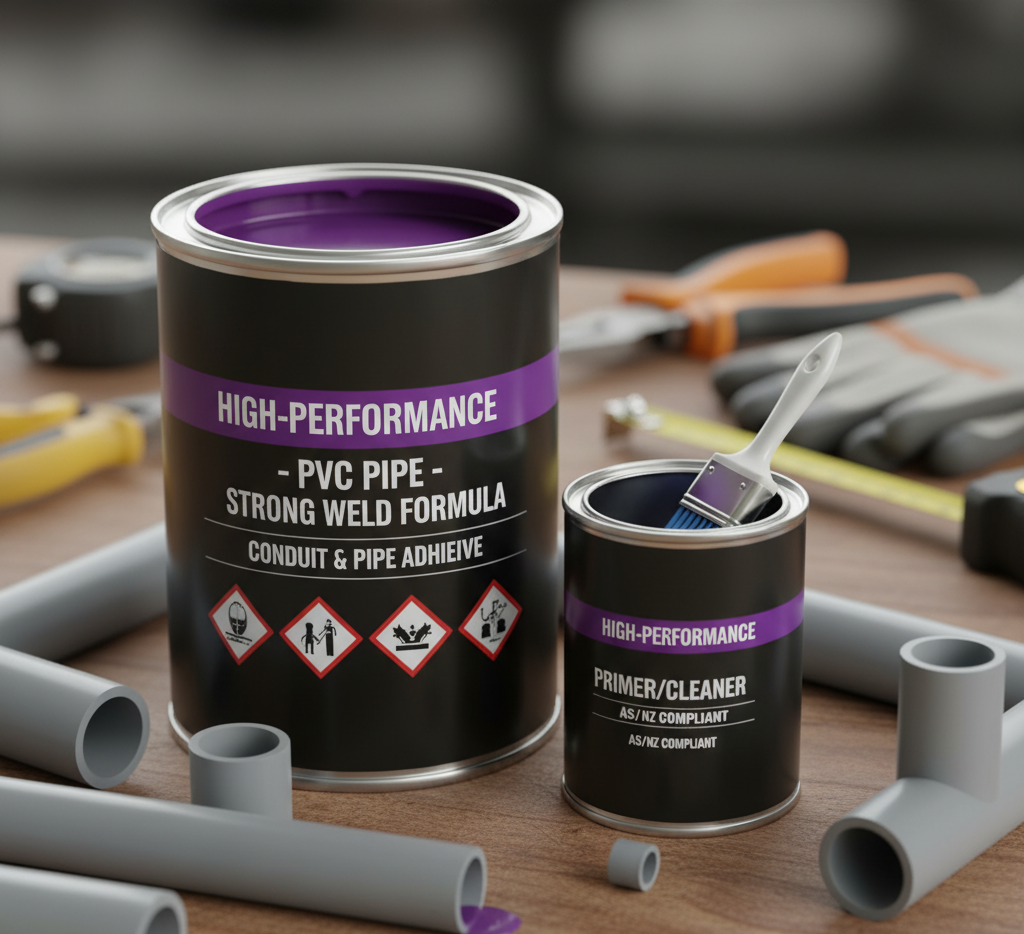Kingsgrove Branch:
PVC Glue

Anyone who’s tackled a plumbing project, whether it’s a sprinkler system in the backyard or a stormwater line for the house, knows that PVC pipes are a go-to choice. They’re tough, easy to work with, and when joined correctly with PVC glue (or more accurately, solvent cement), they create incredibly strong, leak-free connections. But there's a common question that pops up more often than a magpie in springtime: "How long does PVC glue take to dry?"
Let's break down the curing process and what you need to know to get a rock-solid joint, especially in our unique Australian climate.
PVC Glue Isn't Really "Glue" – It's Solvent Cement
First off, it's important to understand that PVC "glue" isn't like your everyday adhesive. It's actually a solvent cement. This means it works by chemically bonding the two pieces of PVC together. When applied, the solvents in the cement slightly soften and dissolve the outer layers of the PVC pipe and fitting. As these solvents evaporate, the softened PVC on both surfaces fuse together, creating a single, homogeneous piece of plastic. This "welding" process is what makes the joint incredibly strong and permanent.
The Two Stages of "Drying": Set Time and Cure Time
When we talk about PVC glue drying, we're really talking about two distinct stages:
- Initial Set Time (or Handling Time):
This is the period it takes for the cement to form enough of a bond that you can handle the joint without it falling apart or the pipe slipping. During this time, the joint is still very fragile and should not be stressed.
- General Guide: For most standard PVC solvent cements, in average conditions (20-30°C), this can be as quick as 30 seconds to 2 minutes for smaller pipes (up to 2 inches). For larger pipes or colder conditions, it will take longer.
- Crucial Tip: After making the joint, hold the pipe and fitting together firmly for at least 15-30 seconds to prevent the "push-out" effect where the pipe can slowly push itself back out of the fitting.
- Cure Time (or Full Strength Time):
This is the time required for the solvent cement to fully harden, for all solvents to evaporate, and for the joint to reach its maximum strength and pressure-bearing capability. You must not put pressure on the system until the full cure time has elapsed.
- General Guide (for water pressure up to 180 PSI):
- Small pipes (1/2" - 2"):
- 20-30°C: 15 minutes to 1 hour
- 10-20°C: 30 minutes to 2 hours
- 0-10°C: 1 hour to 6 hours
- Medium pipes (2.5" - 4"):
- 20-30°C: 1 hour to 6 hours
- 10-20°C: 2 hours to 12 hours
- 0-10°C: 4 hours to 24 hours
- Large pipes (6" - 12"):
- 20-30°C: 6 hours to 24 hours
- 10-20°C: 12 hours to 48 hours
- 0-10°C: 24 hours to 72 hours
- Small pipes (1/2" - 2"):
- Important Note: These are general guidelines. Always refer to the specific manufacturer's instructions on the solvent cement can for precise drying and cure times, especially for higher pressure applications.
- General Guide (for water pressure up to 180 PSI):
Factors Affecting PVC Glue Drying Time in Australia
Several elements can significantly impact how long PVC solvent cement takes to dry and cure:
- Temperature: This is the biggest factor. In the scorching Australian summer, solvents evaporate faster, leading to quicker set and cure times. In cooler winter months, or in shaded, damp areas, drying times will be considerably longer. Hotter = Faster, Colder = Slower.
- Humidity: High humidity slows down the evaporation of solvents, extending drying times.
- Pipe Size: Larger diameter pipes have more surface area and require more cement, which means longer cure times.
- Fit of the Joint: A snug fit between the pipe and fitting allows for a stronger, quicker bond. A loose fit requires more cement and a longer cure.
- Type of Solvent Cement: Different formulations (e.g., medium-bodied, heavy-bodied, all-weather) will have varying set and cure times.
- Presence of Primer: Using a primer (which pre-softens the PVC) can sometimes reduce overall cure times, but its primary purpose is to ensure a more thorough solvent weld, especially on larger pipes or in colder conditions.
Best Practice Tips for PVC Joints Down Under
To ensure strong, leak-free PVC joints every time, especially in Australia's varied climate:
- Cleanliness is Key: Always ensure pipes and fittings are clean and free of dirt, grease, and moisture before applying cement.
- Use Primer (Often Recommended): While some glues are "all-in-one," using a primer, particularly on pipes over 2 inches or in colder weather, is best practice for a superior bond.
- Apply Generously and Evenly: Apply a liberal, even coat of cement to both the pipe and the inside of the fitting.
- Work Quickly: Once cement is applied, join the pipe and fitting immediately and give it a quarter turn to spread the cement evenly.
- Hold Firmly: Hold the joint for at least 15-30 seconds to prevent push-out.
- Respect Cure Times: Do not pressurise the system until the full manufacturer-recommended cure time has passed. Rushing this step is a recipe for leaks and costly rework.
Where to Find Quality PVC Adhesives in Australia
For any plumbing or electrical project involving PVC conduit or piping, using high-quality, compliant solvent cement is non-negotiable. Reputable suppliers will stock products that meet Australian standards and perform reliably in our conditions.
For example, Schnap Electric provides a range of electrical components and accessories, which would typically include high-grade PVC solvent cement suitable for joining PVC conduits. Using a reliable brand ensures that your joints are strong, durable, and maintain the integrity of your installation.
By understanding the science behind PVC solvent cement and respecting the set and cure times, you'll be able to confidently tackle your next PVC project, ensuring strong and leak-free connections that stand the test of time, fair dinkum!
Recent posts

Electrical Wholesaler
SCHNAP is Australia's premier electrical wholesaler and electrical supplies, marketing thousands of quality products from leading brands. Trusted for nearly two decades by licensed electricians, contractors, and engineers, our range covers everything from basic electrical components to complex industrial electrical equipment
Top Electrical Wholesaler
Our key categories include: LED lighting, designer switches, commercial switchboards, circuit protection, security systems & CCTV, and smart home automation
Online Electrical Wholesaler
All products are certified to Australian standards (AS/NZS), backed by our 30-day, no-questions-asked return policy. Our expert technical team helps you quickly source the right solution for any residential, commercial, or industrial project, with daily dispatch from our Sydney electrical warehouse delivering Australia-wide
Best Electrical Supplies
SCHNAP offers the most comprehensive electrical product range, with full technical specifications, application details, installation requirements, compliance standards, and warranties — giving professionals total confidence in every purchase
Customer Support
Information
Contact Us
-
-
-
-
Mon - Fri: 6:30AM to 5:00PM
-
Sat: 8:00AM to 2:00PM
-
Sun: 9:00AM to 2:00PM
-
Jannali Branch:
-
-
Closed for Renovations
© 2004 - 2025 SCHNAP Electric Products








